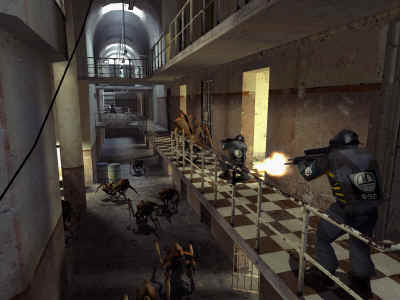 Following up to what many
consider to be the greatest first-person shooter ever made, Half-Life 2 is deep,
ambitious, and to put it in a single word, incredible. While there's plenty of gunfire to
go around, this sequel to the 1998 PC classic features plenty of puzzle solving action.
This mostly revolves around the game's most enjoyable aspect: physics.
Following up to what many
consider to be the greatest first-person shooter ever made, Half-Life 2 is deep,
ambitious, and to put it in a single word, incredible. While there's plenty of gunfire to
go around, this sequel to the 1998 PC classic features plenty of puzzle solving action.
This mostly revolves around the game's most enjoyable aspect: physics. On a surface level, Half-Life 2 is a first person shooter. Enemies approach you, you fire, and they die. There's little to discuss beyond the smooth, natural feel of the controls. The Xbox controller is mapped perfectly, using the d-pad to swap weapons in a convenient manner. It's as efficient as it could be given the decrease in available buttons, and it's more enjoyable for it.
When you're not shooting is when you'll find yourself enjoying this piece of game design the most. Puzzle solving is that unique. While there are sections where it comes down to "find key card A for door B," it's the ones that fall into the real world and have logical solutions that make this fun. Items in the game are interactive more often than not, and by using the game's keen focus on picking up objects, you'll find a way out of nearly every situation.
After years of being forced to dumb down puzzle solving thinking, Half-Life 2 will likely cause you to over think. In the realm of video games, it doesn't seem normal to weigh down a section of floating debris with scattered objects to make a ramp. That's how developer Valve has made the game memorable, and it's obvious from the early going they'll exploit this for as long as they can.
 This is even more apparent when the gravity gun comes into play,
easily the greatest weapon in the history of the genre. Forget about the screen clearing
BFG in Doom. The
gravity gun allows the player to snatch up nearly any object and blast it into the enemy.
Once it's obtained, you'll have numerous opportunities to use it, including scattered saw
blades that nicely dice when shot off. Red barrels provide extra fireworks too. Oddly
enough though, you can't snatch enemies and throw them around for perverse pleasure. It
hardly makes sense.
This is even more apparent when the gravity gun comes into play,
easily the greatest weapon in the history of the genre. Forget about the screen clearing
BFG in Doom. The
gravity gun allows the player to snatch up nearly any object and blast it into the enemy.
Once it's obtained, you'll have numerous opportunities to use it, including scattered saw
blades that nicely dice when shot off. Red barrels provide extra fireworks too. Oddly
enough though, you can't snatch enemies and throw them around for perverse pleasure. It
hardly makes sense.Problems with the game across all versions are still aggravating. Certain sections seem to never end, including a canal chase on an airboat that feels repetitive all the way through (drive, get out on foot, find switch to open gate, drive). There are moments where it's difficult to see where you're supposed to go and if enemies keep coming, that can be frustrating. This is especially prevalent as the game comes to a close.
The Xbox port is an admirable effort, though it's hard to grasp why they didn't wait and put this on the 360. This is straining the console with countless frame rate gaffes, muddy textures (which can be totally unidentifiable; get in close to some of the boats in the canal), and excessive loading times. The first time you put this game in your console, be prepared for what has to be an Xbox record length loading screen. The jarring stoppages while you're playing are tough to deal with too. The PC version created the same complaints, though it takes longer to get things moving again on the Xbox.
 Still, the desolate world is captured like it needs to be. The
opening moments of the game are some of its best. By letting the player walk around and
listen to various conversations, Half-Life 2 is set up like a film. There's no
shooting, running, or action for a solid 20 minutes, yet it prepares the gamer for what
size task they have in front of them.
Still, the desolate world is captured like it needs to be. The
opening moments of the game are some of its best. By letting the player walk around and
listen to various conversations, Half-Life 2 is set up like a film. There's no
shooting, running, or action for a solid 20 minutes, yet it prepares the gamer for what
size task they have in front of them. It's obviously the PC version that carries the edge, with a helpful resolution increase (the Xbox port runs in 480p at best), shorter load times, and stronger graphics engine. It also requires a powerhouse system to run, and given the low cost of the Xbox set up, this is an acceptable way to experience this just-short-of-complete-greatness first person shooter. If this is your only option, there's no reason not to give it a spin.